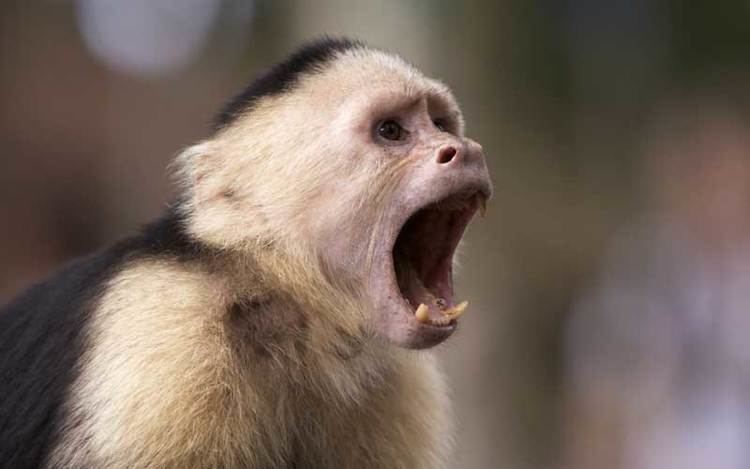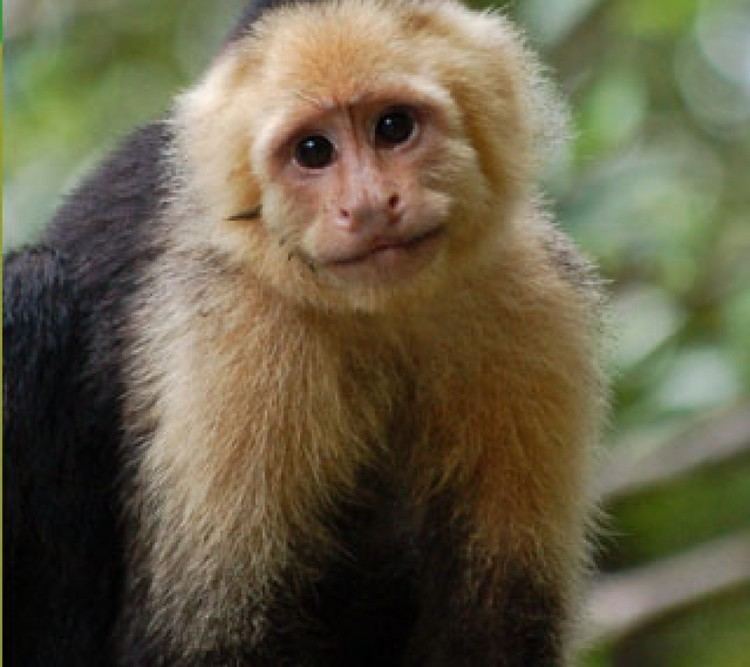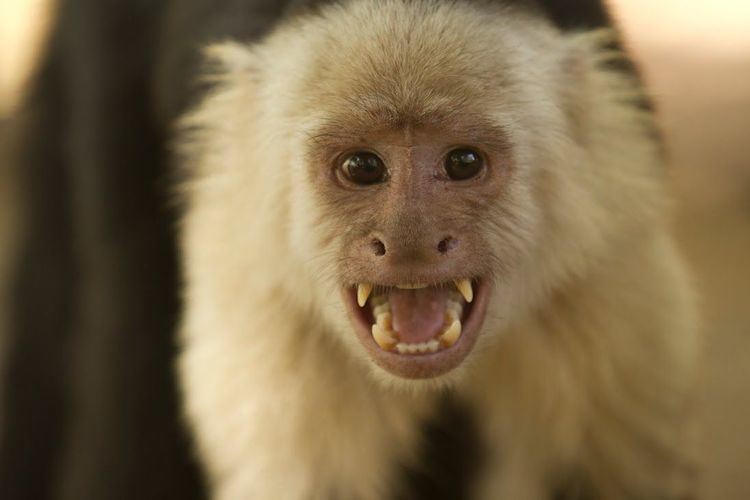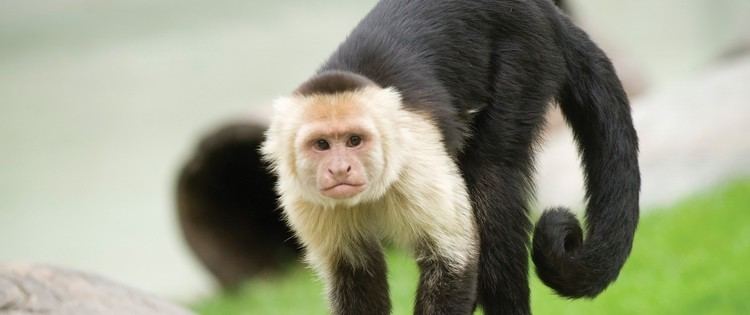Rank Subfamily | Phylum Chordata Scientific name Cebinae | |
 | ||
Lifespan White-headed capuchin: 44 years Gestation period White-headed capuchin: 152 – 183 days Length White-headed capuchin: 34 – 45 cm Mass White-headed capuchin: 2.9 – 3.9 kg, White-fronted capuchin: 3.4 kg Lower classifications White‑headed capuchin, Gracile capuchin monkey | ||
Capuchin monkeys reject unequal pay
The capuchin monkeys (/ˈkæpjʊtʃɪn/ or /ˈkæpjʊʃɪn/) are New World monkeys of the subfamily Cebinae. They are readily identified as the "organ-grinder" monkey, and have been used in several movies and television shows. The range of capuchin monkeys includes Central America and South America as far south as northern Argentina. In Central America, they usually occupy the wet lowland forests on Caribbean coast of Costa Rica and Panama and deciduous dry forest on the Pacific coast.
Contents
- Capuchin monkeys reject unequal pay
- Ucla capuchin monkey project 25 years of a primate drama
- Etymology
- Classification
- Physical characteristics
- Behavior
- Diet
- Social structure and habitat
- Mating
- Life history
- Threats
- Intelligence
- Self awareness
- Theory of mind
- Relationship with humans
- References

Ucla capuchin monkey project 25 years of a primate drama
Etymology

The word capuchin derives from a group of friars named the Order of Friars Minor Capuchin, an offshoot from the Franciscans, who wear brown robes with large hoods. When explorers reached the Americas in the 15th century they found small monkeys whose coloring resembled these friars, especially when in their robes with hoods down, and named them capuchins. When the scientists described a specimen (thought to be a golden-bellied capuchin) they noted that: "his muzzle of a tanned color,... with the lighter color around his eyes that melts into the white at the front, his cheeks..., give him the looks that involuntarily reminds us of the appearance that historically in our country represents ignorance, laziness, and sensuality." The scientific name of the genus, Cebus comes from the Greek word kêbos, meaning a long-tailed monkey.
Classification

The species-level taxonomy of this genus remains highly controversial, and alternative treatments than the one listed below have been suggested.

In 2011, Jessica Lynch Alfaro et al proposed that the robust capuchins (formerly the C. apella group) be placed in a separate genus, Sapajus, from the gracile capuchins (formerly the C. capucinus group) which retain the genus Cebus. Other primatologists, such as Paul Garber, have begun using this classification.

According to genetic studies led by Lynch Alfaro in 2011, the gracile and robust capuchins diverged approximately 6.2 million years ago. Lynch Alfaro suspects that the divergence was triggered by the creation of the Amazon River, which separated the monkeys in the Amazon north of the Amazon River, which evolved into the gracile capuchins, from those in the Atlantic Forest south of the river, which evolved into the robust capuchins. Gracile capuchins have longer limbs relative to their body size than robust capuchins. Gracile capuchins have rounder skulls, whereas robust capuchins have jaws better adapted for opening hard nuts. Robust capuchins have crests and the males have beards.
* Rediscovered species.
Physical characteristics
Capuchins are black, brown, buff or whitish, but their exact color and pattern depends on the species involved. They reach a length of 30 to 56 cm (12 to 22 in), with tails that are just as long as the body.
Behavior
Like most New World monkeys, capuchins are diurnal and arboreal. With the exception of a midday nap, they spend their entire day searching for food. At night, they sleep in the trees, wedged between branches. They are undemanding regarding their habitat and can thus be found in many differing areas.
Diet
The capuchin monkey feeds on a vast range of food types, and is more varied than other monkeys in the family Cebidae. They are omnivores, and consume a variety of plant parts such as leaves, flower and fruit, seeds, pith, woody tissue, sugarcane, bulb, and exudates, as well as arthropods, molluscs, a variety of vertebrates, and even primates. Capuchins have been observed to also be particularly good at catching frogs. They are characterized as innovative and extreme foragers because of their ability to acquire sustenance from a wide collection of unlikely food, which may assure them survival in habitats with extreme food limitation. Capuchins living near water will also eat crabs and shellfish by cracking their shells with stones.
Social structure and habitat
Capuchin monkeys inhabit a large range of Brazil and other parts of Latin and Central America. Capuchin monkeys often live in large groups of 10 to 35 individuals within the forest, although they can easily adapt to places colonized by humans. Usually, a single male will dominate the group, and they have primary rights to mate with the females of their group. However, the white-headed capuchin groups are led by both an alpha male and an alpha female. Each group will cover a large territory, since members must search for the best areas to feed. These primates are territorial animals, distinctly marking a central area of their territory with urine and defending it against intruders, though outer areas may overlap. The stabilization of group dynamics is served through mutual grooming, and communication occurs between the monkeys through various calls. Capuchins can jump up to nine feet (three meters), and they use this mode of transport to get from one tree to another. They remain hidden among forest vegetation for most of the day, sleeping on tree branches and descending to the ground to find drinking water.
Mating
Capuchin females often direct most of their proceptive and mating behavior towards the alpha male. However, when the female reaches the end of her proceptive period, she may sometimes mate with up to six different subordinate males in one day. Strictly targeting the alpha male does not happen every time, as some females have been observed to mate with three to four different males. When an alpha female and a lower-ranking female want to mate with an alpha male, the more dominant female will get rights to the male over the lower-ranking one.
Life history
Females bear young every two years following a 160- to 180-day gestation. The young cling to their mother's chest until they are larger, when they move to her back. Adult male capuchins rarely take part in caring for the young. Juveniles become fully mature within four years for females and eight years for males. In captivity, individuals have reached an age of 45 years, although natural life expectancy is only 15 to 25 years.
Threats
Capuchin monkeys are clever and easy to train. As a result, they are used to help people who are quadriplegics in many developed countries. They have also become popular pets and attractions for street entertainment, and are hunted for meat by local people. Since they have a high reproductive rate and can easily adapt to their living environment, loss of the forest does not negatively impact the capuchin monkey populations as much as other species, although habitat fragmentation is still a threat. Natural predators include jaguars, cougars, jaguarundis, coyotes, tayras, snakes, crocodiles and birds of prey. The main predator of the tufted capuchin is the harpy eagle, which has been seen bringing several capuchins back to its nest.
Intelligence
Capuchins are considered the most intelligent New World monkeys and are often used in laboratories. The tufted capuchin is especially noted for its long-term tool usage, one of the few examples of primate tool use other than by apes. Upon seeing macaws eating palm nuts, cracking them open with their beaks, these capuchins will select a few of the ripest fruits, nip off the tip of the fruit and drink down the juice, then seemingly discard the rest of the fruit with the nut inside. When these discarded fruits have hardened and become slightly brittle, the capuchins will gather them up again and take them to a large flat boulder where they have previously gathered a few river stones from up to a mile away. They will then use these stones, some of them weighing as much as the monkeys, to crack open the fruit to get to the nut inside. Young capuchins will watch this process to learn from the older, more experienced adults but it takes them 8 years to master this.
In 2005, experiments were conducted on the ability of capuchins to use money. After several months of training, the monkeys began exhibiting behaviors considered to reflect understanding of the concept of a medium of exchange that were previously believed to be restricted to humans (such as responding rationally to price shocks). They showed the same propensity to avoid perceived losses demonstrated by human subjects and investors. They also may trade sex for money.
During the mosquito season, they crush millipedes and rub the result on their backs. This acts as a natural insect repellent.
Self-awareness
When presented with a reflection, capuchin monkeys react in a way that indicates an intermediate state between seeing the mirror as another individual and recognizing the image as self.
Most animals react to seeing their reflection as if encountering another individual they do not recognize. An experiment with capuchins shows that they react to a reflection as a strange phenomenon, but not as if seeing a strange capuchin.
In the experiment, capuchins were presented with three different scenarios:
- Seeing an unfamiliar, same-sex monkey on the other side of a clear barrier
- Seeing a familiar, same-sex monkey on the other side of a clear barrier
- A mirror showing a reflection of the monkey
With scenario 1, females appeared anxious and avoided eye-contact, while males made threatening gestures. In scenario 2, there was little reaction by either males or females.
When presented with a reflection, females gazed into their own eyes and made friendly gestures, such as lip-smacking and swaying. Males made more eye contact than with strangers or familiar monkeys, but reacted with signs of confusion or distress, such as squealing, curling up on the floor, or trying to escape from the test room.
Theory of mind
The question of whether capuchin monkeys have a theory of mind—whether they can understand what another creature may know or think—has been neither proven nor disproven conclusively. If confronted with a knower-guesser scenario, where one trainer can be observed to know the location of food and another trainer merely guesses the location of food, capuchin monkeys can learn to rely on the knower. This has, however, been repudiated as conclusive evidence for a theory of mind as the monkeys may have learned to discriminate knower and guesser by other means. Until recently it was believed that non-human great apes did not possess a theory of mind either, although recent research indicates this may not be correct. Human children commonly develop a theory of mind around the ages 3 and 4.
Relationship with humans
Easily recognized as the "organ grinder" or "greyhound jockey" monkeys, capuchins are sometimes kept as exotic pets. Sometimes, they plunder fields and crops and are seen as troublesome by nearby human populations. In some regions, they have become rare due to the destruction of their habitat.
They are also used as service animals, sometimes being called "nature's butlers". One organization has been training capuchin monkeys to assist quadriplegics as monkey helpers in a manner similar to mobility assistance dogs. After being socialized in a human home as infants, the monkeys undergo extensive training before being placed with a quadriplegic. Around the house, the monkeys help out by doing tasks including fetching objects, turning lights on and off, and opening drink bottles.
In 2010, the U.S. federal government revised its definition of service animal under the Americans with Disabilities Act (ADA). Non-human primates are no longer recognized as service animals under the ADA. The American Veterinary Medical Association does not support the use of nonhuman primates as assistance animals because of animal welfare concerns, the potential for serious injury to people, and risks that primates may transfer dangerous diseases to humans.
